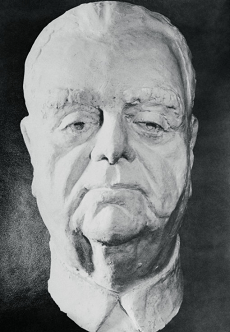
This thoughtful study of the late Aga Khan, 48th Imam of Shia Imami Ismailis, was done in clay by his wife, the Begum Aga Khan, Om Habiba. Image by © Bettmann/CORBIS
Editor’s note: The following piece is an adaptation from Bashir Ladha’s excellent tribute to the 48th Ismaili Imam, His Highness the Aga Khan III, which appeared in Ilm, Volume 3, Number 2 (November 1977, Special Centenary issue). Many of the themes in Mr. Ladha’s original article, such as the Imam’s Jubilees and his contributions to different causes and issues, were adequately covered in a special series on H.H.The Aga Khan III published on this Web site during November and December 2009. This adaptation includes some material that was not presented on this Web site earlier. Some repetition, though, is unavoidable.
BIRTH AND EARLY EDUCATION
His Highness the Aga Khan III, Hazrat Imam Sultan Muhammad Shah, was born on Friday, 2nd November, 1877 at “Honeymoon Lodge” in Karachi. His birth was an occasion of immense joy for the family and particularly his grandfather, Hazrat Imam Hassanali Shah, Aga Khan I, who named him “Sultan Muhammad.”
The young Aga Khan did not attend any public school, but his early education at home was intense. The scope of the curriculum set by his tutors and his far-seeing mother, Lady Ali Shah, covered Urdu, Persian, Arabic, English, French, Mathematics, Astronomy, Chemistry and Mechanics. He showed remarkable aptitude for learning. His natural intellect and interest also helped him to make remarkable progress in Western literature as well as in the study of the history of the ancient and modern worlds. He also acquired proficiency in philosophy and theology.
Recalling his course of studies, the Aga Khan wrote:
“I had already been grounded in Arabic and Persian literature and history, and first inspired thereto in childhood, to this day I take a special interest in historical studies connected with the early Caliphs. Under my English tutors, I gained an attachment, which also remains with me, to the writings of the more stirring and eloquent of the English historians and of the foremost novelists—particularly Gibbon, Thackeray and Dickens.”
YOUNG IMAM EXHIBITS ABLE LEADERSHIP AND WISDOM
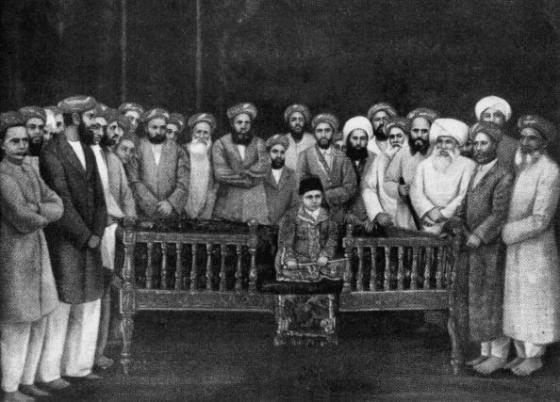
September 1, 1885: The 7-year-old Aga Khan III at his enthronement ceremony as 48th Imam of the Shia Ismaili Ismaili Muslims in Bombay. He is surrounded by community elders. Photo: Keystone/Hulton Archive/Getty Images, Copyright
When Imam Sultan Muhammad Shah succeeded his father Imam Aly Shah as the 48th Imam of Ismaili Muslims on 17th August, 1885, he was only in his eighth year but even at this tender age he administered the affairs of his followers with a maturity of wisdom which was very surprising.
Long before he had reached the age of fifteen, Imam Sultan Muhammad Shah proved himself an able administrator of the affairs of his vast following. He visited the Jamats and resolved disputes with a legal acumen seldom found in those who are not lawyers. The Aga Khan worked incessantly for the benefit of his followers and not being content to lead the Ismailis in religious matters, he strove hard for their moral and material welfare with the result that, in the course of only a few decades, the Ismailis earned a reputation of being a progressive and forward looking community.
A WELL INFORMED PERSONALITY
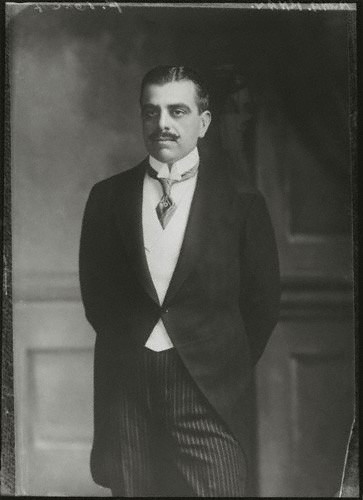
Sir Sultan Muhammad Shah, Aga Khan III, photographed in 1911, Copyright: National Portrait Gallery
Though his range of reading was wide, Imam Sultan Muhammad Shah’s impressions of men and things were practical and not theoretical. His judgements were based not upon what he had read but upon what he had seen and heard. Lloyd George (Prime Minister of Great Britain during early 1920s) said of him:
“He is one of the best informed men I have ever met. His general information is astonishing. He is extraordinarily well read and possesses an intimate knowledge of international affairs in all parts of the world. He is widely travelled and is always moving round the capitals of Europe, in all of which he has influential intimates. His means of securing information were remarkable. He seemed to have touched upon all branches of literature and to be well versed in science. Altogether a very extraordinary person.”
A TRUE LEADER OF ISLAM; ALAS MUSLIMS DID NOT TAKE ADEQUATE HEED
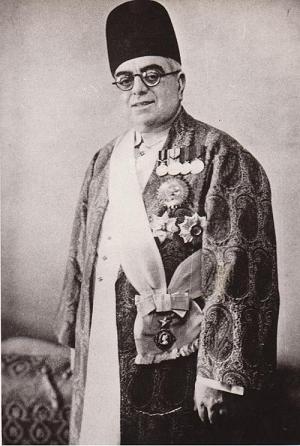
Sir Sultan Muhammad Shah Aga Khan, 48th Imam of Shia Imami Ismailis, in full regalia. Photo: Jehangir Merchant archives
Imam Sultan Muhmmad Shah never tolerated anything that was detrimental to Islam and therefore he would not hesitate in the least to make his views known publicly. Islam was always foremost in his heart and he would always appeal to the Muslims in a beseeching and affectionate manner:
“My fellow-Muslims, I implore you, I beg of you, to work for the advancement of the whole of Islam, but never forget our intellectual debt to our Holy Prophet.”
Generally, very little heed was paid by the Muslims to Imam Sultan Muhammad Shah’s guidance and therefore, lamenting over this attitude, Qayyum A. Malick wrote in his book Guide, Philosopher and Friend of the World of Islam:
“Had world Muslims kept pace with the progressive views of Prince Aga Khan and had they showed some encouraging consciousness and appreciation of his leadership, the seeds of moral and material uplift sown by him almost half a century ago would have been bearing abundant fruit today. If the Muslims had thrown up a small body of trustworthy men, capable of working in unison according to a set program of general advancement under the leadership of His Royal Highness there should have been no occasion to bemoan our backwardness now.”
For the Ismailis, Hazrat Imam Sultan Muhammad Shah’s period of Imamat was an era which ushered in a complete transformation. A community hitherto unknown in any field, progressed rapidly to unimagined heights within a matter of a few decades. What happened to Ismaili Community during his Imamat is nothing less than a miracle.
In his role as the 48th Imam, Hazrat Imam Sultan Muhammad Shah, set about to advance and consolidate the position of Ismailis at all levels. Under his guidance, a great spirit of social service, philanthropy and love for one another became a notable feature of the community. This attitude of mutual help among themselves and the smooth working of the welfare state created by Hazrat Imam Sultan Muhammad Shah won unmistakeable admiration of the leaders of other communities. Mahatma Gandhi once observed to Imam Sultan Muhammad Shah:
“I have been striving for so many years for the attainment of Swaraj (independence), but you have already brought the blessings of Swaraj to your people.”
While the Imam created numerous institutions to advance and consolidate education, health and general state of happiness and well being among his follower, he upheld a high mark of abiding values. True to the traditional and historically acknowledged trait of his Holy House, he put the spiritual goal as the prime and foremost essential of human life.
RELIGIOUS GUIDANCE TO HIS FOLLOWERS COVERED IMAMAT, PRAYERS, UNITY AND ATTRIBUTES OF A TRUE MU’MIN
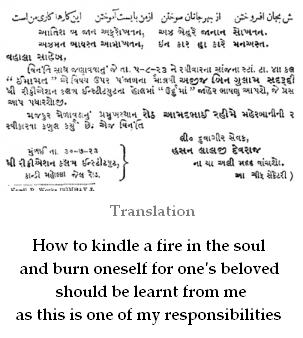
- The top portion of the image is a unique 1923 Gujarati invitation to a talk on Imamat. It includes a Persian quatrain on the top line. The quatrain had been handwritten by Aga Khan III in a personal diary belonging to Vazir Mecklai. The English translation of the quatrain, not part of the invitation, is produced beneath. Photo credit: A.M. Sadaruddin family collection of ‘Africa Ismaili’. Visit H.H. The Aga Khan III page for link to complete article
His advice on religious matters to his followers were extensive and elaborate. The late Aga Khan touched on many themes during his seventy two years of Imamat including theology, spirituality, Imamat and ethics. Some of his messages to the Ismailis were:
“Qur’an was basic. Pir Sadardin [an Ismaili missionary] had come to their ancestors to lead them to the true faith. It was essential to have strong faith in the descendants of Prophet Muhammad and Hazrat Ali. If the faithful had love for the descendants of Ali, they had nothing to fear, and therein lay the whole mystery of faith. True faith was founded upon love and reason.
“The faithful should come and pray in the Jamatkhana. Prayers must be said with understanding. Pray for others as this brings one nearer to God. By prayer one rises to a higher plane. If the faithful was far from Jamatkhana he should say his prayers wherever he was. Even if the body was unclean, prayers could not be missed. The soul was pure. Unity in the Jamat was important. All his murids were spiritual children of their Imam, who was their spiritual father and mother.
“Harm done to another would cause immense pain to the Imam. Help each other. Serve the jamats. Service to jamats was service to their Imam. True mu’min (believer) was always happy and satisfied. True mu’min rejoiced at difficulties, for such sorrows and difficulties wiped away sins. True mu’min never feared death.”
And finally, “that a true mu’min would always thirst for Imam’s Noorani Didar. True mu’min, after death, would earn salvation in Noor-e-Imamat.”
PASSING AWAY AND SUCCESSION
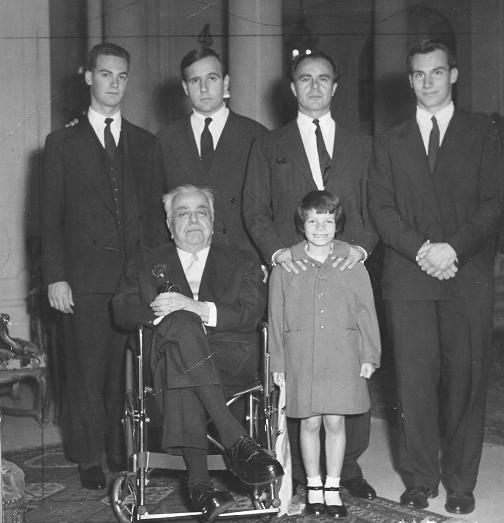
A Portrait of the Aga Khan Family of the mid 20th century: Next to the late 48th Ismaili Imam, Aga Khan III, is his grand daughter, Princess Yasmin. Standing from left to right - grandson Prince Amyn Muhammad, his two sons the late Prince Sadruddin and Prince Aly Khan holding daughter, and second grandson Prince Karim, the present Imam. Photo: Zul Khoja Collection, Ottawa.
Forty minutes past midday on 11th July, 1957 Hazrat Imam Sultan Muhammad Shah, His Highness the Aga Khan III, passed away peacefully at his villa in Versoix, Switzerland, at the age of eighty leaving behind him a memorable history of his glorious and eventful life. His reign of seventy-two years of Imamat was the longest in Ismaili history.
The mantle of Imamat was transferred by Nass in the loving care of Mowlana Shah Karim al-Hussaini Hazar Imam, His Highness the Aga Khan IV, by the following will:
“Ever since the time of my first ancestor Ali, the First Imam, that is to say over a period of thirteen hundred years it has always been the tradition of our family that each Imam chooses his successor at his absolute and unfettered discretion from amongst any of his descendants whether they be sons or remoter male issue.
“. . . I appoint my grandson Karim, the son of my son Aly Salomone Khan to succeed to the title of Aga Khan and to be the Imam and Pir of all my Shia Ismailian followers. “
The passing away of Imam Sultan Muhammad Shah was a cause of great sorrow and sadness for Ismailis all over the world, but the loving care and guidance of Noor-e-Ilahi continues in Noor Mowlana Shah Karim aI Hussaini, our beloved 49th Imam, who is now in his 54th year of Imamat.
Article publication date: November 2, 2010 (133rd birth anniversay of Aga Khan III)
Article updated: November 3, 2010
© Simerg.com
___________________
Highly recommended:
For links to articles, unique images and historical photos, as well as review movies of Imam Sultan Muhammad Shah, please click H.H.The Aga Khan III.
Please visit the Simerg Home page for links to articles posted most recently. For links to articles posted on this Web site since its launch in March 2009, please click What’s New. Sign-up for blog subscription at top right of this page.

Thank you for this knowledge spreading article about our beloved 48th Imam. We were so blessed with his guidance and what he accomplished for humanity at large. He blessed us by leaving us with a scientific Imam for the scientific world.
It is good to remember what our Imams have done for us and I am lucky to be an Ismaili…..Hussain Hanif
Thank you so much for this beautiful article on our late Imam Sultan Muhammad shah. It’s very much inspiring.
Thank you for posting these nice photos with the article.
The late Aga Khan III was certainly one of the greatest leaders of Muslim world. The current Aga khan IV is being recognized and valued on the global stage particularly in the West from the dawn of the 21st century onwards through the initiatives of the AKDN and other Imamat institutions.
Thank you for this fine piece. Our Imams provide guidance in the style which befits the time. We have to learn from their wisdom and aspire to excellence in all walks of life. Shukar for the guidance we have.